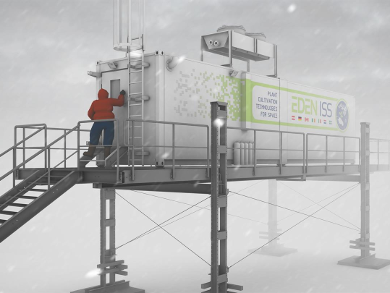By the end of 2017, the EDEN ISS greenhouse will supply the German Neumayer III Antarctic station operated by the Alfred Wegener Institute (AWI) with fresh fruit and vegetables. With the greenhouse, the researchers will also test how fresh plant-based food could be cultivated on the International Space Station (ISS) and during future missions to the Moon and Mars. However, to do so, a great deal of state-of-the-art technology is required.
An essential factor for horticulture in extreme conditions is having the right water supply. Large water tanks are installed in the floor of the greenhouse container. In the eternal ice, these will be filled with previously melted, filtered, and purified water from the Neumayer III. Every 5–10 minutes, the plants will be sprayed automatically with a water-nutrient mixture so that they can be cultivated completely without using soil. This process, called aeroponics, saves the transportation of large quantities of soil.
The air in the greenhouse will be adapted as much as possible to the needs of the plants. To keep the air free of harmful germs and fungal spores, various air filters as well as a system for air sterilization using UV radiation are installed. Like a space station, the greenhouse will have a completely closed air circuit, including an airlock through which the researchers will enter the greenhouse. The closed circuit also allows all the water that the plants release into the air to be recovered and fed back to them.
To adjust the lighting for each plant species individually, a water-cooled LED system in which each LED can be individually controlled via a computer is built. The plants will be illuminated for 16 hours in a simulated day-night rhythm and will have eight hours of nightly rest without light. In addition to this dim LED light, there will be a white light for the researchers to work in the greenhouse.
EDEN ISS Coordinator Daniel Schubert, DLR Institute of Space Systems, Bremen, Germany, thinks that installation of basic supplies will be completed around Christmas, followed by the working area, the changing room, and the computer technology. After that, a trial will start at the DLR site in Bremen. In October 2017, the greenhouse will be shipped to Antarctica.
Numerous international partners are working together under the leadership of DLR: Alfred Wegener Institute, Germany, and Wageningen University and Research, The Netherlands, Airbus Defence and Space, Germany, LIQUIFER, Austria, the National Research Council, Italy, the University of Guelph, Canada, Enginsoft, Italy, Thales Alenia Space, Italy, Aero Sekur, Italy, Heliospectra, Sweden, Limerick Institute of Technology, Ireland, and Telespazio, Italy.
- Deutsches Zentrum fuer Luft- und Raumfahrt e. V. (German Aerospace Center; DLR), Cologne, Germany




